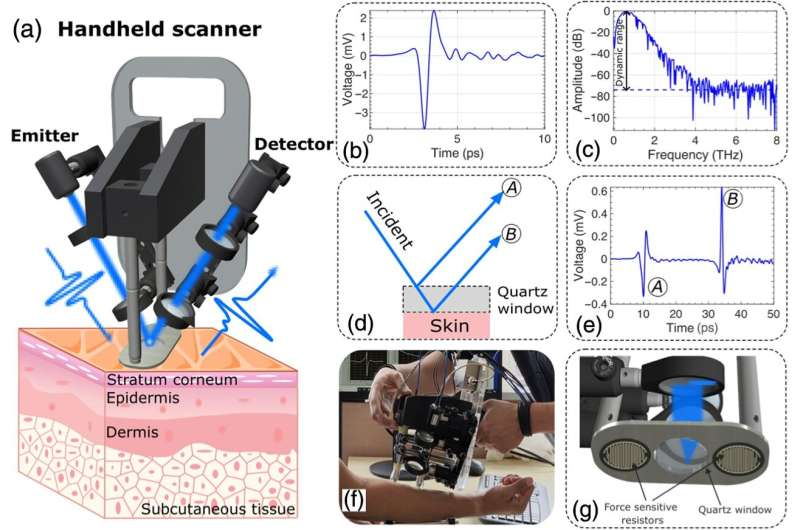
The portable THz handheld scanner. (a) Handheld system and skin diagram. (b) A single raw THz reference signal reflected from a gold mirror and the result of averaging 20 pulses. (c) Fourier spectra indicating that averaging increases the dynamic range by over 10 dB. (d) Diagram illustrating the two reflections of the THz pulse, one from the air–quartz interface labeled as “A,” and one from the quartz–skin–air interface labeled as “B.” (e) Example of a typical THz-TDS trace reflected from the interface air–quartz (A) and quartz–skin (B). (f) Photograph of the handheld probe scanning the volar forearm of a volunteer. (g) Two force-sensitive resistors are fitted on the tip of the probe to ensure consistent force applied onto the skin for every measurement. Credit: Advanced Photonics Nexus (2024). DOI: 10.1117/1.APN.3.1.016012
Ahead of International Day of Women and Girls in Science this Sunday, 11 February, The University of Warwick is shining the spotlight on a physicist who is developing new technology to advance the diagnosis and screening of skin cancers.
Professor Emma MacPherson, who recently became the first-ever female and youngest person to receive the International Society of Infrared, Millimeter, and Terahertz Waves (IRMMW-THz) Society’s Exceptional Service AwardLink, is investigating the use of terahertz radiation in medical imaging.
Her latest research is published this week on the Advanced Photonics Nexus.
Unlike X-rays, terahertz radiation is non-ionizing; unable to pass through water, it does not harm tissues within the body. This means humans can be safely exposed to the rays repeatedly, with none of the health risks associated with X-rays. While the potential benefits of terahertz radiation are known, its practical application is less well-developed.
That is why Professor MacPherson and her team at the University’s Department of Physics are building a screening device using terahertz frequencies—something she has been working on for two decades.
Professor MacPherson said, “Terahertz waves are between microwaves and infrared in the electromagnetic spectrum, and less energetic and harmful than X-rays and ultraviolet radiation. By using these waves, we are able to see changes in skin hydration levels. In areas of skin cancer, the flow of blood and water changes in the affected skin—this can be detected using terahertz. We’re now developing instrumentation to work accurately on people in the clinical setting.”
Alongside her current project, Professor MacPherson has driven infrared and terahertz wave research over the years and supported the academic community. She hosted the IRMMW-THz conference in Hong Kong in 2015, arranging subsidiaries for students who couldn’t afford their own travel to the event.
She has also helped set up a prize for students in the field and serves on the committee for the recently established Zhenyi Wang Award, which is for young women involved in terahertz research. She is also one of only five women who sit on the IRMMW-THz international organizing committee.
This month, Professor MacPherson spoke of being “delighted” to receive the IRMMW-THz Society’s Exceptional Service Award—which she is due to accept at the society’s conference in Australia later in the year.
Professor MacPherson added, “Having worked in the field for more than half my life, it was an honor to receive the Exceptional Service Award. While typical winners have been over 60 and male, I have always found the community so welcoming, and that has given me less apprehension about breaking the mold—always encouraging me to move forward. In fact, colleagues have actively helped me break down any barriers, and I want to do the same for others.”
“I was commended for organizing the society’s conference in 2015—something I did while on maternity leave. It was actually great timing for me, as I could keep my visibility up in academia while enjoying some downtime out of the lab. I know this is something that many new mums in academia worry about—it’s definitely an issue we face, but it shouldn’t hold us back. I hope that this International Day of Women and Girls in Science I can offer inspiration to other women in scientific research.”
More information:
Arturo I. Hernandez Serrano et al, Terahertz probe for real time in vivo skin hydration evaluation, Advanced Photonics Nexus (2024). DOI: 10.1117/1.APN.3.1.016012
Citation:
Physicist advancing skin cancer screening and diagnosis using terahertz waves (2024, February 9)
retrieved 9 February 2024
from https://phys.org/news/2024-02-physicist-advancing-skin-cancer-screening.html
This document is subject to copyright. Apart from any fair dealing for the purpose of private study or research, no
part may be reproduced without the written permission. The content is provided for information purposes only.
>>> Read full article>>>
Copyright for syndicated content belongs to the linked Source : Phys.org – https://phys.org/news/2024-02-physicist-advancing-skin-cancer-screening.html
